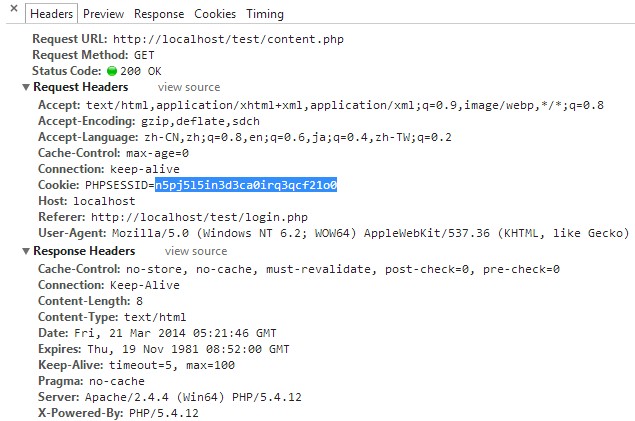第一步:先在本地写一个登陆页面和一个内容页面(登陆了才能进去)吧。代码:
下面是login.php,用于请求登陆的,通过post传递参数,如果登陆成功就会注册session。
复制代码 代码如下:
<?php
session_start();
if (isset($_post['username'])) {
$username = $_post['username'];
$password = $_post['password'];
if ($username == 'admin' && $password == 'admin') {
$_session['username'] = $username;
echo "<a href='content.php'>进入网站</a>";
} else {
echo "-1";
}
}
?>
<html>
<body>
<form action="" method="post">
<input type="text" name="username" />
<input type="password" name="password" />
<input type="submit" name="submit" value="submit" />
</form>
</body>
</html>
下面是content.php,会验证session,用来当网站的内容页,登陆了才能看到正确的内容。
复制代码 代码如下:
<?php
session_start();
if (isset($_session['username'])) {
echo "login ok";
} else {
echo "not login";
}
?>
接下来先讲httpurlconnection这个类,先使用这个类直接请求content.php页面,理所应当的返回了"-1"。如果先用这个类去请求login.php,并传递正确的参数,就会显示登陆成功,这个时候再去用这个类请求content.php,依然是返回"-1",很显然,httpurlconnection并没有记录我们登陆的状态,或者说服务器认识刚刚登陆成功的人,但这次请求content.php的人它依然不认识。这就说明了httpurlconnection的每一次请求都是独立的,都是一次新的请求,或者说每一次请求都是一个新的会话(session)。
然后我就用chrome去开我自己写的那个测试的网页,发现在同一个网站下,同一次会话中,有一个sessionid是不会变的。
就是上面这个东西,如果开着某个页面,无论如何刷新,或者跳转到这个服务器下的其他网站,这个sessionid的值都不会改变,但是如果关掉这个服务器下的所有页面,再重新打开这样的一个页面,这个sessionid的值就被重新生成了。
 于是用httpurlconnection的情况,第一次登陆login.php是一个sessionid,确实登陆成功了,服务器记住的是sessionid为a的情况(假设是a好了),但再去请求content.php的时候,sessionid就不是a了,服务器就认为你没有登陆,于是就显示了“-1”。问题搞明白了,那么只需要在httpurlconnection请求的时候,给它加上sessionid这个头部就行了。最终代码如下:
于是用httpurlconnection的情况,第一次登陆login.php是一个sessionid,确实登陆成功了,服务器记住的是sessionid为a的情况(假设是a好了),但再去请求content.php的时候,sessionid就不是a了,服务器就认为你没有登陆,于是就显示了“-1”。问题搞明白了,那么只需要在httpurlconnection请求的时候,给它加上sessionid这个头部就行了。最终代码如下:
复制代码 代码如下:
public class nethelper {
/**
* sessionid
* */
private string sessionid = "";
/**
* 发送一条请求,将内容以字符串返回
* @param url 请求的地址
* @return 返回的内容
* */
public string request(string url) throws ioexception {
url uurl = new url(url);
httpurlconnection huc = (httpurlconnection) uurl.openconnection();
huc.addrequestproperty("cookie", sessionid); //为什么是“cookie”,chrome打开f12自己看看就明白了
huc.connect();
bufferedreader br = new bufferedreader(new inputstreamreader(huc.getinputstream()));
string data = "";
string line = "";
while ((line = br.readline()) != null) {
data = data + line;
}
return data;
}
/**
* 发送登陆请求,并将sessionid保存起来
* @param url 登陆请求的地址
* @return 返回的内容
* */
public string login(string url) throws ioexception {
url uurl = new url(url);
httpurlconnection huc = (httpurlconnection) uurl.openconnection();
//设置请求方式
huc.setrequestmethod("post");
//设置post参数
stringbuffer params = new stringbuffer();
params.append("username=").append("admin").append("&").append("password=").append("admin");
byte[] bytes = params.tostring().getbytes();
huc.getoutputstream().write(bytes);
huc.connect();
//从headers中取出来,并分割,为什么要分割,chrome打开f12自己看看就明白了
string[] aaa = huc.getheaderfield("set-cookie").split(";");
sessionid = aaa[0];
bufferedreader br = new bufferedreader(new inputstreamreader(huc.getinputstream()));
string data = "";
string line = "";
while ((line = br.readline()) != null) {
data = data + line;
}
return data;
}
}
接下来就是使用httpclient,代码类似的,我做了相同的实验,结果就直接出来了,httpclient会自动的管理session,第二次请求不需要手动去设置session就可以登录上。
复制代码 代码如下:
public class netclient {
private httpclient client = null;
public netclient() {
client = new defaulthttpclient();
}
public string request(string url) throws clientprotocolexception, ioexception {
httppost post = new httppost(url);
httpresponse res = client.execute(post);
bufferedreader br = new bufferedreader(new inputstreamreader(res.getentity().getcontent()));
string data = "";
string line = "";
while ((line = br.readline()) != null) {
data = data + line;
}
return data;
}
public string login(string url) throws clientprotocolexception, ioexception {
httppost post = new httppost(url);
//设置post参数的方式还真是不人性化啊……
arraylist<namevaluepair> pa = new arraylist<namevaluepair>();
pa.add( new basicnamevaluepair( "username", "admin"));
pa.add( new basicnamevaluepair( "password", "admin"));
post.setentity( new urlencodedformentity(pa, "utf-8"));
httpresponse res = client.execute(post);
bufferedreader br = new bufferedreader(new inputstreamreader(res.getentity().getcontent()));
string data = "";
string line = "";
while ((line = br.readline()) != null) {
data = data + line;
}
return data;
}
}
最后总结一下,session验证的方式是在一次会话中,为每一个客户端都生成了一个sessionid,如果是成功登陆的,服务器端就会记录好,登陆成功的sessionid,如果登陆失败或者新的sessionid,都将无法验证登陆,这就是session验证登陆的基本情况。
而httpurlconnection和httpclient这两个类都可以用来网络请求,但稍有不同,httpurlconnection每一次请求都是新的会话,如果需要去验证sessionid,就必须手动的去设置header,httpclient就能智能的管理session,不需要手动设置,实际上httpclint就类似于一个程序中的小浏览器。
最大的槽点我觉得就是这两个类设置post参数的方式都很2b一点都不方便……
另外httpclient不能同时发送两次请求,如果一个请求还没有结束或者关闭,又马上开启另一个请求。就会报警告,截个图吧

以后还是尽量都使用httpurlconnection吧。
 于是用httpurlconnection的情况,第一次登陆login.php是一个sessionid,确实登陆成功了,服务器记住的是sessionid为a的情况(假设是a好了),但再去请求content.php的时候,sessionid就不是a了,服务器就认为你没有登陆,于是就显示了“-1”。问题搞明白了,那么只需要在httpurlconnection请求的时候,给它加上sessionid这个头部就行了。最终代码如下:
于是用httpurlconnection的情况,第一次登陆login.php是一个sessionid,确实登陆成功了,服务器记住的是sessionid为a的情况(假设是a好了),但再去请求content.php的时候,sessionid就不是a了,服务器就认为你没有登陆,于是就显示了“-1”。问题搞明白了,那么只需要在httpurlconnection请求的时候,给它加上sessionid这个头部就行了。最终代码如下: